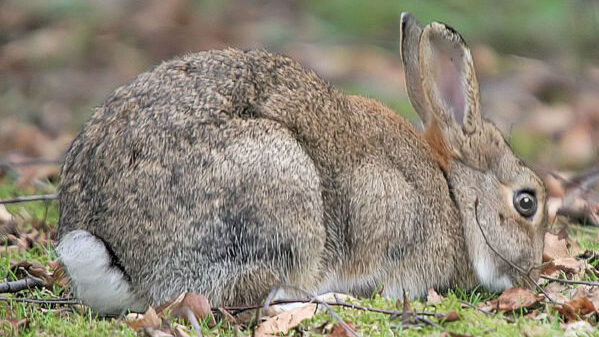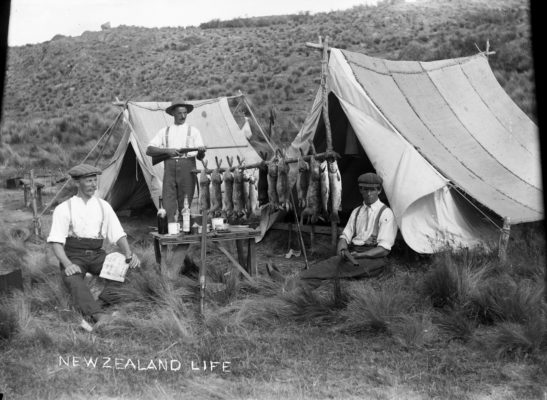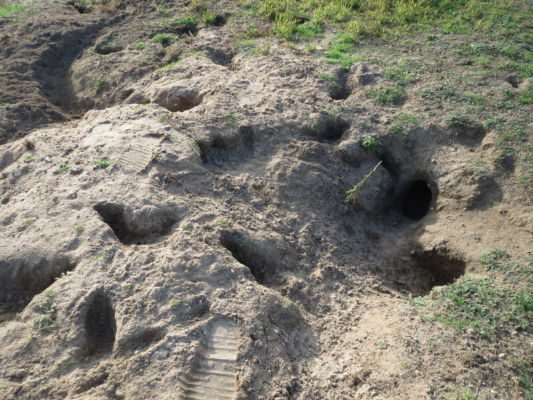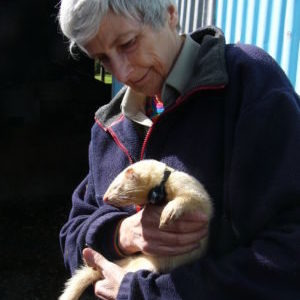With the benefit of hindsight, its easy to condemn those who released rabbits in New Zealand and even more so, those who then released ferrets and stoats to ‘remedy’ the earlier error. What were they thinking? Did they really have no other control options open to them? Were they completely unaware of what the consequences would be for our native wildlife?

Carolyn King (University of Waikato) has researched historical documents and newspapers to reveal the dilemmas and debates of 130 years ago, in an article recently published in International Review of Environmental History.
First of all, the rabbits – how did they get here and why? It seems the rabbits first arrived earlier than you might expect.
“The first rabbits to arrive in New Zealand were probably brought by whalers to the south coast of the South Island. They were a normal article of trade at shore stations, so were shipped from Sydney during the two decades of the 1820s–1830s along with other supplies. There were reports of sightings of rabbits in southern New Zealand in the 1840s and 1850s, although only in small numbers. As colonisation proceeded, rabbits were transported and liberated by settlers in several other parts of New Zealand, for sport as well as for meat.”
Even some of our earliest settlers realised it wasn’t a great idea.

“One story, about the introduction of rabbits to Southland in 1863, describes the occasion when four rabbits, brought to Bluff on the immigrant ship Helenslea from Scotland, were liberated in the sandhills near Invercargill:
There was a liberation ceremony with speeches and toasts drunk in champagne. But … an old Highlander named Mitchell … stood on a sandhill and cursed the rabbits in Gaelic, saying they would ruin the country. No one paid much attention at the time … but many of those present must have lived to see the day [when Mitchell was proved right] … and remember his words.
It didn’t take long for numbers to increase and problems to arise.
“From the early to mid-1870s, burrowing and pasture damage by rabbits was beginning to cause serious reductions in sheep numbers, wool clip and lambing percentages associated with malnutrition of the breeding ewes. The consequent decline in the value of pastoral land set back by decades the development of pastoralism, the dominant source of income of the young colony.”
What’s more, many of those who had the most to lose were New Zealand’s wealthy South Island runholders – a group which also commanded a great deal of political influence at the time.
“By 1882, more than 1,000 runs were established, of which all but 26 were in the South Island. Three-quarters of the 1.3 million acres (526,091 ha) of pastoral land occupied in 1882, and two-thirds of the runs, lay in Otago and Canterbury. These two provinces also supplied more than half of the national wool clip for export. Hence the runholders in those areas, especially those in Otago, had a disproportionately large influence on the colonial secretary’s policy concerning rabbits. Many of them were members of the Squatters’ Club in Dunedin, the local equivalent of the best gentlemen’s clubs in London, with the same connections with the levers of power.”
One of those runholders was Cuthbert Cowan – and he had a serious rabbit problem on his land.
“Cuthbert Cowan was a leading Southland runholder and a member of the House of Representatives. His property at Okaiterua on the Oreti River was one of the first to be invaded by rabbits, from 1872 onwards. Between March and July 1876, Cowan killed 26,000 rabbits on his own 11,750 acres (4,755 ha) alone, by the efforts of men with spades, dogs and one gun. He organised a private shipment of ferrets from Britain, which arrived in late 1876.”
As the ‘natural enemy’ of rabbits, ferrets were considered an obvious solution by some – but not everyone agreed.
“Arguments over the wisdom of importing predators to attack rabbits soon developed into a serious political issue, focused on the strongly worded protests from ornithologists concerned about the risk to endemic fauna, including avian predators native to New Zealand. The same year, Sir George Grey attempted to prohibit the importation of foxes, polecats, stoats and weasels. He proposed a Noxious Animals Introduction Prevention Bill that would have made such imports illegal.”
Saving native species wasn’t the only motivation for the Bill.
“The debate was stimulated at least as much by concerns about the potential damage to acclimatised game birds as by the potential threat to native birds. Grey’s bill was passed by the House of Representatives, but the upper house, the Legislative Council, refused to consider it. Many members of the council were wealthy runholders at risk of losing serious amounts of money if the rabbit pest could not be controlled.”
As rabbit numbers continued to spiral out of control, rabbit-free Canterbury was threatened with invasion by rabbits from both Marlborough and Otago/Southland. Large shipments of ferrets were imported and many more were then bred locally.
“Ferrets had long been useful for purposes other than release, such as for clearing buildings of rats, so private imports had been going on since the late 1860s. ‘Working ferrets’ were trained to hunt rabbits alongside a man and a team of dogs. Ferrets were inserted into the burrows to flush the rabbits out into the jaws of the dogs, and afterwards retrieved. The area of ground that a ferreting team could cover was limited, and the need to control rabbits over vast areas of seldom-visited mountain country was very great. Inevitably, the emphasis shifted to importing ferrets in very large numbers, specifically to be liberated into the wild.”
Ferrets were, however, found to be bad travellers – particularly when sailing ship journeys took several months and those caring for the ferrets lacked knowledge of the animals. Catching distemper from dogs was also a frequent cause of shipboard fatalities. Losses were costly.
“600 ferrets were imported by George Bullen of Kaikoura, but every one of that consignment died. He started again with 700 and got two ferrets out of the 1,300.”
The failure to control rabbits wasn’t just costing the runholders. The government of the day was losing out too.
“By 1881 the rental income to the government from the half-million acres (202,342 ha) of runs severely affected by rabbits had dropped from £2,288 a year to £619, and the financial cost to the whole colony in lost exports had escalated to at least £500,000 a year. Opponents continued to claim that ferrets would prove to be a cure worse than the disease, but any such prediction could be countered by reassurances from supporters of the programme, such as C. J. Tully. He told the Joint Committee on Sheep and Rabbits in 1884 that ferrets were so easy to catch, there was no need to fear that ferrets would become too numerous.”
Benmore Station was one of many that established its own ferret-breeding facility.
“In April 1888, 689 ferrets were turned out on the station, most of them locally bred. Still, rabbit numbers remained astronomical: 40,000 were killed on Benmore in February–March 1889 alone.”
Ferret-breeding even became an enterprising business for some, such as a private ferret stud at Wairuna Hills (inland from Balclutha) run by Messrs Allen and Riggs.
“They had a contract to supply the colonial government with 10,000 ferrets a year for three years, at 7s 6d a head. The breeding stock numbered 200 full-grown ferrets, of which 40 were males. They ate 30 rabbits a day, plus the milk of three cows, and every detail of their diet, housing, mating, and nursing of offspring was carefully managed to keep them healthy.”
Poaching could be lucrative too.
“In districts where large numbers of ferrets had already been turned out, a high price offered for live ferrets gave rabbiters an incentive to poach wild ferrets and offer them for sale.”
Overall, breeding ferrets seems to have been a flourishing industry.

“Ferret breeding was now being carried out on a large scale; 3,600 ferrets had been bred and 2,755 released in Otago, 367 in Canterbury, 480 in Marlborough, in addition to more than 4,000 by private owners. A separate report lists contracts on foot for a total of 21,760 ferrets to be supplied to the government’s stock department from 1 January 1887 to 8 June 1888. All the consignees were rabbit inspectors in the South Island, although a footnote adds that fewer than half of the contracts were expected to be met.”
A year or so later, when the government stopped all contracts, ferret breeders then released 5,000 of their stock.
“In all, the 50-year history of attempts to use ferrets to control rabbits in the South Island involved tens of thousands of animals. An unpublished estimate by the historian R. M. Burdon estimates that overall ‘upward of 75,000’ ferrets were bred and released.”
With so many ferrets aided and abetted to breed, spread and kill rabbits, why didn’t this early ‘biological control method’ work? Professor King explains.
“First, it is necessary to draw a clear distinction between two quite different predator– prey relationships. Island species that evolved in habitats free of any four-footed mammalian predators, which include all of New Zealand’s most strongly endemic birds, typically have very low breeding and mortality rates. Suddenly increased subtraction imposed by a new invader can easily beat multiplication of the residents, and reproduction is overwhelmed by unmanageable losses, as is illustrated by the long list of New Zealand’s extinct birds.”
But ‘natural’ predator/prey relationships of mainland species work differently. It’s not in the evolutionary interest of either species, if one completely wipes the other out.
“A ‘natural enemy’ in this sense is the product of an evolved interaction that includes the mutually adaptive population dynamics and flexible behaviour that allow long-term coexistence at landscape scale. The impact of invasive rodents and mustelids on New Zealand’s native fauna was overwhelmingly of the disastrous new-invader kind; that of ferrets on rabbits, the accommodating old-enemy kind.”
Ultimately there was no sustained and widespread benefit from introduced ferrets killing rabbits and a great deal of harm continues to be done by both species, over a century later. A few key lessons were, however learned.
“Ferrets could affect rabbit populations only given certain conditions. First, that rabbit numbers had to be first reduced so far as possible by other means. The quickest way of doing this was by poisoning the rabbits in winter, but the timing had to be correct to avoid the risk of ferrets eating the poisoned rabbits; otherwise they would be found dead all over the run. Second, that ferrets must be turned out in early spring and in sufficient numbers; those liberated only a few at a time on thickly infested ground could not be expected to cope with the number and increase in rabbits. Third, that no rabbit trappers can be employed anywhere that ferrets are working, since rabbit traps kill ferrets as well as rabbits. As one runholder reported: ‘So long as we employed rabbiters, the rabbits increased’. Another ‘tried [rabbit] trapping and caught 70 ferrets’.”
Ultimately, ferret numbers were and are determined by rabbit numbers rather than vice versa.
“Now, ferrets themselves are a declared noxious species, subject to control campaigns even though ferret numbers are more likely to be determined by rabbit numbers than by human action, especially in the semi-arid pastoral lands where they were first released.”
Ferrets failed, essentially, because they couldn’t keep up.
“Ferrets cannot match the breeding rate or running speed of rabbits; their underground searching is comparatively slow and inefficient and they disperse slowly on foot; rabbits can hide in and escape from complex burrow systems, and rapidly reinvade a cleared area; they are alert and can fight back, so are risky for a ferret to kill compared with other equally acceptable native prey, including lizards and flightless birds; wild ferrets stop to eat after killing one grown rabbit or a nest of infants, and resume hunting only when necessary—the rabbits are left to multiply while the ferrets rest rather than produce more ferrets.”
While people knew much less about population dynamics and predator/prey relationships a century ago, naturalists did warn of the risk to native birds. Unfortunately, politics and economics prevailed.
“The people whose personal and financial interests were most affected by the rabbits were more often the absentee leaseholders of large pastoral runs in the backcountry rather than the smaller-scale farmers who knew and closely managed their own land. These same leaseholders held disproportionate influence over colonial policy through their social connections and their majority membership in the Legislative Council. They were all strongly in favour of importing the natural enemy of the rabbit for release on the backcountry, as opposed to the far more expensive and labour-intensive manual methods of rabbit control that could be effective in more closely settled districts. In particular they found that employing professional rabbiters merely encouraged the sustained harvesting of rabbits. ‘If you want to breed rabbits keep rabbiters’, said one.”

There are things we can learn from such failed experiments, even with our greater knowledge of ecology today.
“Tempting though it may be, it is inappropriate to use twenty-first-century knowledge to criticise decisions made by the colonial government. On the contrary, their experience has illustrated some valuable principles of pest management applicable today. Ambitious strategies for managing invasive pests (rats, mustelids and Australian brushtail possums) are now being developed in New Zealand, informed by long experience of past campaigns, including those against rabbits. Managing pest populations by lethal means has a long history, and developments in more and better ways of killing individual pests are advancing rapidly. These new methods can prevent short-term damage to threatened species and are important despite their drawbacks because they can buy us time to find something better. But pest populations are determined by the dynamic balance between the numbers input (fertility, immigration) versus output (mortality, emigration), all of which are locally and seasonally variable. The most effective lethal methods are those that are accompanied by some means of reducing fertility in the remaining pest population.”
Where to, for the future?
“A stable future pest-management policy must depend on interactions between finding new ways of culling the most pervasive pest populations and managing the reproductive capability of the remainder, in both cases by using techniques operable at landscape scale and by socially acceptable means. Finding new ways of increasing mortality, such as by moving beyond the effective but controversial aerial distribution of 1080 poison, and reducing fertility, such as by genetic manipulation of the sex ratio of offspring, are under active investigation. Both will take much longer than simple damage prevention, because they are part of a problem whose solution depends not only on technical expertise but also on widespread social approval and collaboration; but the will to succeed is there.”
The full article is published in International Review of Environmental History and freely available through Researchgate:

